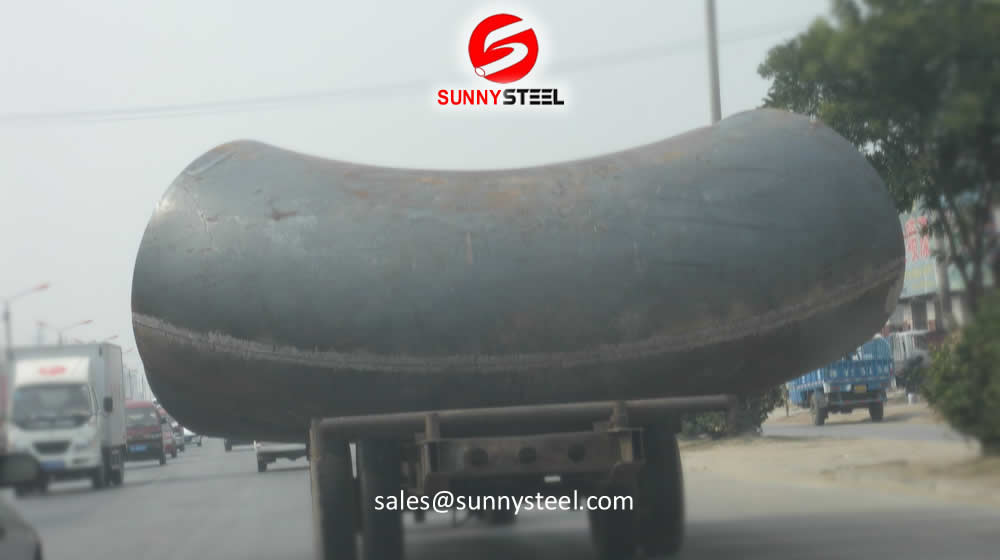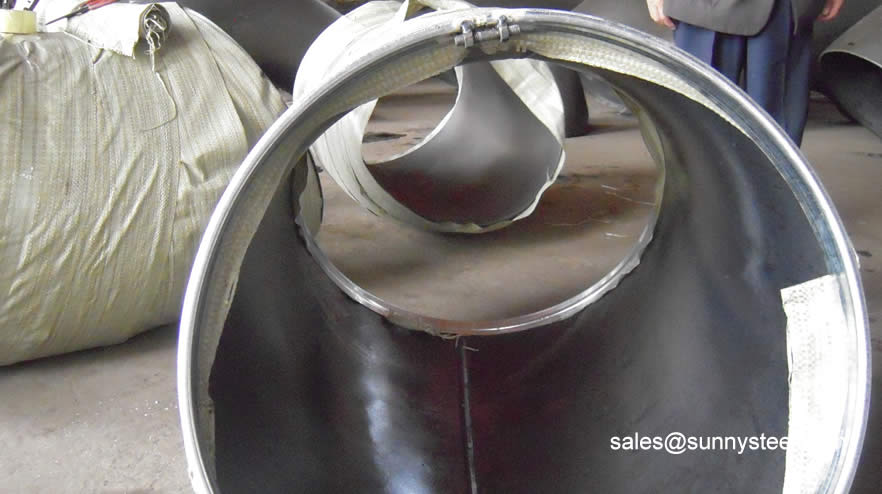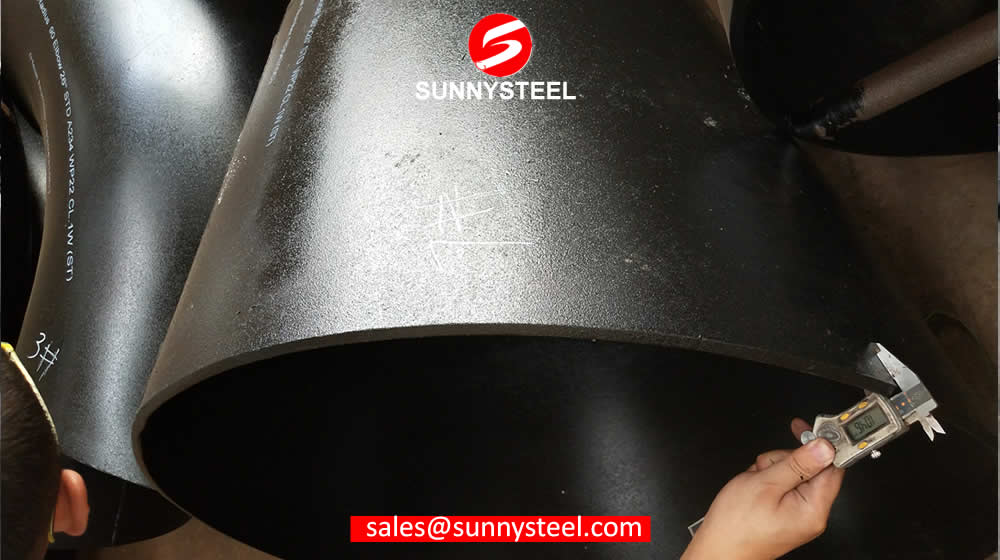Butt-welded pipe bending
Butt-welding is the process of joining two pieces of material together along a single edge in a single plane.
This process can be used on many types of materials, though metal and thermoplastics are the most common. When two sheets of steel are laid side-by-side and joined together along a single joint, this is an example of butt-welding.
We are passionate about pipe bending:
Pipe bend, Bend pipe, Pipe bending, ANSI, ISO, JIS and DIN Standards, Measures 1/2 to 56 Inches.
The bend is used to change the direction of run of pipe.it advantage is can matach long distance transition requirements,so it is commonly that bends dimension according to customer design. usually,the bends consist of 3D, 5D, 7D and 12D series.
Methods of bends in carbon steel
While the industry provides various means for bending the carbon steel pipe to the 5D bend, heat induction is the most widely-known–but not the most popular–technique in the industry. The pipe to be bent is subjected to extreme temperature, and when at the desired heat, a mode or model in the dimensions of the 5D bends is forced through the heated pipe, causing the pipe to conform to the bend of the 5D pipe dimensions. Carbon steel is the hardest pipe material used in this manner, and heat induction is the best means to curve the carbon steel pipe into the 5D curvature.
Uses
Heat-processed 5D bend pipes are used in all oil and gas lines, and the factory testing exceeds the quality standards required by the oil and gas industry. This is an industry where quality standards can be linked to safety standards.
What You Are Buying
Customers obtain a wide range of bend geometries and total design flexibility with customized radius and angle. Qualified subcontractors carry out hot induction bending with state-of-the-art technology, giving full control of the bending process, as well as total monitoring of all bending parameters.
1) Heat Induction Bends for Oil and Gas Industry
The production of high-quality bends depends on the manufacturing process of the steel pipe that is transformed into the bend. During the hot-induction bending process, unavoidable thinning occurs. Therefore, a custom- and precision-made mother pipe must be produced in order to comply with minimum wall thickness after the bending is complete.
Heat treatment is carried out on each bend in order to achieve the required degree and mechanical properties after bending. For critical applications (such as high-strength steel, heavy wall, sour service or low-temperature) full quenching and tempering after bending is still performed as a preferred process. Machining the bend ends guarantees top tolerances of inside diameters of the pipe. We therefore ensure the bend has the minimum working strengths of the mother pipe.
World-class bending manufacturers provide high quality bending solutions for oil and gas pipelines, either onshore or offshore. The bends manufacturing and testing procedures exceed all quality standards required by the oil and gas industry.
2) Cold Bending Process
High quality bending solutions are more than critical. Cold-bending is commonly used over hot-bending because certain types of steel and metal alloys can be weakened. You cannot allow the pipes to be weakened in any way as this can lead to damage of your product, your plant, or cause risks of injury to your employees. Cold-bending is also preferred by many industries because of its affordability, with costs being less than that of heat induction.
Cold-bending 5D bends is a continuous operation where a long strip of metal, usually steel, is passed through sets of rollers, with each set of rollers performing only a part of the bend, until the desired cross-section profile is obtained. Roll-forming is ideal for producing parts with long lengths or in large quantities. Roll-Forming is also generally a lower cost process than other metal forming processes. Cold-processed bends are used in construction, water piping and as machinery parts.
Sunny Steel provides fast, dependable metal custom-bending for:
- angle
- flat bar
- round tube
- pipe
- square tube
- Ibeams
- channel
- finned tube
We specialize in bending, fabricating and testing of heating and cooling coils. We are proud of our leading reputation in the industry with our attitude of professional workmanship and on-time delivery. Some of our advantages over competitors include:
- Fast Turnaround Times
- Dependability
- Outstanding Reputation
- Custom Pipe Bending
- Custom Oil Field Bending
- Architectural Application Bending
- Heating and Cooling Coil Fabrication
Sunny Steel fabricates all types and sizes of cooling coils from 1/8″ pipe to 8″ pipe and all alloys.
Pipe bending reference
Just before the final delivery, our merchandise are stringently checked by a team of quality analyzers on varied parameters, which guarantee their flawlessness and durability. In addition, clients can avail these goods from us at competitive rates.
Standards
ASTM
- ASME/ANSI B16.49 Factory-Made Wrought Steel Buttwelding Induction Bends for Transportation and Distribution Systems
- ASTM A403 Standard Specification for Wrought Austenitic Stainless Steel Piping Fittings
- ISO 2851 tainless steel bends and tees for the food
JIS
- JIS B2311 Universal steel butt-welding pipe fittings
- JIS B2312 Steel butt-welding pipe fittings
- JIS B2313 Steel plate butt-welding pipe fittings
- JIS B 2321:1995Aluminium and aluminium alloy butt-welding pipe fittings
EURO
- DIN 3867 Non-soldering compression couplings - Pressure bush for butt joints
- DIN 2609 Steel butt-welding pipe fittings; technical delivery conditions
- BS 1640 Specification for steel butt-welding pipe fittings for the petroleum industry
- BS 1965 Butt welding pipe fittings for pressure purpose
- STPG38
Inspection, packing & delivery
Materials
They are manufactured utilizing higher grade raw material, advanced machines and technologies.
- Abrasion resistant: Cearmic lined, Ceramic tile, Bi-metal clad pipe bending, Rare earth alloy wear-resistant pipe bending
- Carbon steel:
- SA234 WPB, SA234 WPC,SA42 WPL6, SA42 WPL3
- WP1. MSS-SP75, WPHY,WPHY 46,WPHY 52
- WPHY 56,WPHY 60,WPHY 65, WPHY 70
- DIN 1629 St37, RST37.2 St52, STPG38
- Stainless:
- ASTM/ASME SA403 304,304L ,316, 316L, WP304L, 3 WP316 WP347 (H) ,WP317 (L),WP321.
- DIN 1.4301, 1.4306, 1.4401, 1.4571
- JIS SUS304,SUS304, SUS304L, SUS316, SUS316
- Alloy:
- ASTM/ASME SA234 WP12, WP11,WP22, WP5, WP9, WP91, ASTM B361 GR.3003-6061, ASTM B366 UNS
- N04400,N08800, N08825 N1001-N10276-N10665, WPT2-WPT12
- ASTM 182 F1, F5, F6, F7, F9, F11, F12, F22, F51, 16MnR Cr5Mo
- 12Cr1MoV 10CrMo910 15CrMo 12Cr2Mo1, St45.8

Pipe bend FAQs
Pipe fittings are necessary to join together pipes, or to change the direction of an existing pipe. Pipes and pipe fittings are made of a variety of materials, depending on the fluid or gas being transported. Most pipe fittings tend to be either threaded or able to slip over the pipes they connect. Whether you are using steel pipes of PVC pipes, a chemical solvent is required to create a seal between the pipe and the fittings.
Measure the required length of the pipe to be installed, keeping in mind the extra length required where the pipe will be inserted into the fitting. Mark this length on the pipe.
How to Calculate a Pipe Bend?
Pipe fittings are necessary to join together pipes, or to change the direction of an existing pipe. Pipes and pipe fittings are made of a variety of materials, depending on the fluid or gas being transported. Most pipe fittings tend to be either threaded or able to slip over the pipes they connect. Whether you are using steel pipes of PVC pipes, a chemical solvent is required to create a seal between the pipe and the fittings.
Measure the required length of the pipe to be installed, keeping in mind the extra length required where the pipe will be inserted into the fitting. Mark this length on the pipe.
Bevelled Ends
The ends of all buttweld fittings are bevelled, exceeding wall thickness 4 mm for austenitic stainless steel, or 5 mm for ferritic stainless steel. The shape of the bevel depending upon the actual wall thickness. This bevelled ends are needed to be able to make a "Butt weld".
Welding Bevel acc.to ASME / ANSI B16.9 and ASME / ANSI B16.28
ASME B16.25 covers the preparation of buttwelding ends of piping components to be joined into a piping system by welding. It includes requirements for welding bevels, for external and internal shaping of heavy-wall components, and for preparation of internal ends (including dimensions and dimensional tolerances).
Our in-hourse R&D team developed bevel ends equipment are good using in thickness 2mm to 20mm pipe fittings, guarantee high efficiency and high quality.
Send us your technical drawings
These weld edge preparation requirements are also incorporated into the ASME standards (e.g., B16.9, B16.5, B16.34).
ASME B16.25 (BUTT WELD ENDS)
Buttweld Fittings general
A pipe fitting is defined as a part used in a piping system, for changing direction, branching or for change of pipe diameter, and which is mechanically joined to the system.
There are many different types of fittings and they are the same in all sizes and schedules as the pipe.













